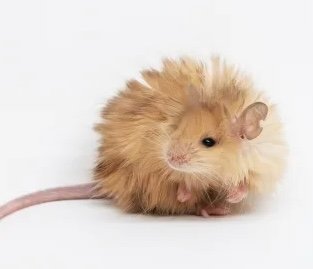The creation of the mammoth mouse and bringing back extinct species.
This week the private company, Colossal Biosciences, sent out a press release that they had successfully inserted Woolly Mammoth DNA into a transgenic mouse. This discovery brings us, as a society, one step closer to bringing back extinct species. The company Colossal biosciences claims in its swanky website that the Woolly Mammoth is a key to climate resilience. This resurrection will allow mammoths to “compact permafrost slowing the rate of thawing of the arctic” or you know whatever they need to say to justify their project.
The adorable mammoth mouse Source: CNN
Any news of species resurrection harkens back to the famous Jurassic park. Readers will remember that the first scene in the book describes a child dying after being bitten by a tiny venomous dinosaur. This dinosaur was previously unknown to have venom until it was brought back to life and then very quickly escaped. It’s difficult to say if life imitates art or if we are just obsessed with messing with genetics. We can be fairly sure that the mammoth isn’t hiding giant vampire like fangs but we also can’t be sure they will slow the rate of climate change.
Critics of the project suggest that this money could be better spent elsewhere. What about the species already extinct, or rather on the brink of extinction?
Let’s imagine for a minute that we are on the timeline that involves us thwarting climate change and healing the earth. We make it to 2030 and magically we reverse global warming and replenish lost habitat. We will be in a position to bring back extinct species, and this technology currently does not exist.
I had the privilege of touring the Frozen Zoo last year at the San Diego Zoo Safari Park. A sort of modern day Noah’s Ark of DNA and embryos. The building itself is locked behind a series of high security fences, key card access, and a guest sign in sheet. The room is in the basement of the building and on its own electrical grid. It’s an unassuming space filled with vats of liquid nitrogen. It is reminisccent of a morgue rather than an ark. The program employs a single full time ambassador who is the spokesperson for the project. The project was started by Dr. Kurt Benirschke (or Dr. KB as he was called by colleagues) in 1970. At that time the technology did not exist to revive frozen embryos (in vitro fertilization nowadays) but he believed it would be in the near future. He predicted that in the future we would be able to bring whole species back from extinctions and thus started the frozen zoo. Within the quiet halls, over 10,000 samples of DNA and embryos lie at rest. The project has already made massive strides in the field of reproductive engineering. Most of the animals that have benefited from the program have yet to go extinct but they do hope to one day work on an extinct species. The program has now expanded to two locations and contains some of the only samples of DNA from extinct species in the world. When the future arrives where resurrection of species is possible, these are the species that will benefit.
According to Colossal’s website over 50% of species will become extinct by 2050 should we not change our course. Therefore this technology could be very valuable.
At the moment the technology is still far off, however Colossal claims to have a mammoth walking the earth by 2028. The leap from mouse to mammoth is a big one. Colossal will need to implant an embryo into an elephant surrogate and have her carry it to term. Elephants are tricky breeders, they are pregnant for 12 months and they have tight family groups. The first implantation will most likely fail. If it does succeed there is a high probability that the offspring will die within the first year. Subjecting an Elephant surrogate to a high risk pregnancy and then an even higher risk birth is an ethical nightmare. If you haven’t noticed we aren’t exactly flush with spare elephants.
Most scientists agree that the first species to bring back should be a bird. They lay eggs, that incubate outside the body. They reproduce much quicker than mammals, and they don’t tend to notice when the egg is gone. Most of the time they can be fooled with a dummy egg if necessary. Why colossal chose mammoths is most likely for shock factor. If you are going to be first at something why not be first at the biggest something. The idea that they would simply release a 500 million dollar science project on the arctic tundra is comical. The first mammoths will be in a zoo, and will cost at least 50$ per person to see.
In addition to this future GMO zoo that Colossal seems on track to build, they are at their core a biotech company. They are committed to this project to patent and sell technology from the process of genetic engineering. They are gambling that what ever breakthrough they experience will earn them a lot of money. They have reason to believe this. Just take a look at Monsanto’s Round Up ready corn variant. We can not be certain that their technology will be available to conservation efforts in the future. Their intentions might be pure but there is always a catch.
We have seen enough ethical climate minded companies take a quick 180 degree turn as soon as the investors start rolling in.
Sources:
https://science.sandiegozoo.org/resources/frozen-zoo%C2%AE
https://www.cnn.com/2025/03/04/science/woolly-mouse-mammoth-resurrection-colossal/index.html


































































































